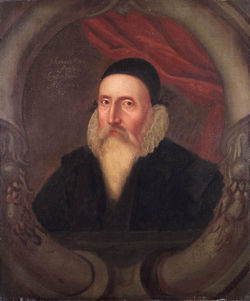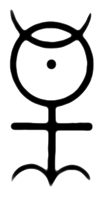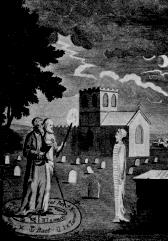John Dee
2007 Schools Wikipedia Selection. Related subjects: Mathematicians

John Dee ( July 13, 1527- 1608) was a noted British mathematician, astronomer, astrologer, geographer, occultist, and consultant to Queen Elizabeth I. He also devoted much of his life to alchemy, divination, and Hermetic philosophy.
Dee straddled the worlds of science and magic just as they were becoming distinguishable. One of the most learned men of his time, he had lectured to crowded halls at the University of Paris when still in his early twenties. He was an ardent promoter of mathematics, a respected astronomer and a leading expert in navigation, having trained many of those who would conduct England's voyages of discovery (he coined the term "British Empire"). At the same time, he immersed himself deeply in magic and Hermetic philosophy, devoting the last third of his life almost exclusively to these pursuits. For Dee, as with many of his contemporaries, these activities were not contradictory, but particular aspects of a consistent world-view.
Biography
Early life
Dee was born in Tower Ward, London to a Welsh family, whose surname derived from the Welsh du ("black"). His father Roland was a mercer and minor courtier. Dee attended the Chelmsford Chantry School (now King Edward VI Grammar School (Chelmsford)), then – from 1543 to 1546 – St. John's College, Cambridge. His great abilities were recognized, and he was made a founding fellow of Trinity College. In the late 1540s and early 1550s, he travelled in Europe, studying at Leuven and Brussels and lecturing in Paris on Euclid. He studied with Gemma Frisius and became a close friend of the cartographer Gerardus Mercator, returning to England with an important collection of mathematical and astronomical instruments. In 1552, he met Gerolamo Cardano in London: during their acquaintance they investigated a perpetual motion machine as well as a gem purported to have magical properties.
Dee was offered a readership in mathematics at Oxford in 1554, which he declined; he was occupied with writing and perhaps hoping for a better position at court. In 1555, Dee became a member of the Worshipful Company of Mercers, as his father had, through the company's system of patrimony.
That same year, 1555, he was arrested and charged with "calculating" for having cast horoscopes of Queen Mary and Princess Elizabeth; the charges were expanded to treason against Mary. Dee appeared in the Star Chamber and exonerated himself, but was turned over to the reactionary Catholic Bishop Bonner for religious examination. His strong and lifelong penchant for secrecy perhaps worsening matters, this entire episode was only the most dramatic in a series of attacks and slanders that would dog Dee through his life. Clearing his name yet again, he soon became a close associate of Bonner.
Dee presented Queen Mary with a visionary plan for the preservation of old books, manuscripts and records and the founding of a national library, in 1556, but his proposal was not taken up. Instead, he expanded his personal library at his house in Mortlake, tirelessly acquiring books and manuscripts in England and on the European Continent. Dee's library, a centre of learning outside the universities, became the greatest in England and attracted many scholars.
When Elizabeth took the throne in 1558, Dee became her trusted advisor on astrological and scientific matters, choosing Elizabeth's coronation date himself. From the 1550s through the 1570s, he served as an advisor to England's voyages of discovery, providing technical assistance in navigation and ideological backing in the creation of a "British Empire", and was the first to use that term. In 1577, Dee published General and Rare Memorials pertayning to the Perfect Arte of Navigation, a work that set out his vision of a maritime empire and asserted English territorial claims on the New World. Dee was acquainted with Humphrey Gilbert and was close to Sir Philip Sidney and his circle.
In 1564, Dee wrote the Hermetic work Monas Hieroglyphica ("The Hieroglyphic Monad"), an exhaustive Cabalistic interpretation of a glyph of his own design, meant to express the mystical unity of all creation. This work was highly valued by many of Dee's contemporaries, but the loss of the secret oral tradition of Dee's milieu makes the work difficult to interpret today.
He published a "Mathematical Preface" to Henry Billingsley's English translation of Euclid's Elements in 1570, arguing the central importance of mathematics and outlining mathematics' influence on the other arts and sciences. Intended for an audience outside the universities, it proved to be Dee's most widely influential and frequently reprinted work.
Later life
By the early 1580s, Dee was growing dissatisfied with his progress in learning the secrets of nature and with his own lack of influence and recognition. He began to turn towards the supernatural as a means to acquire knowledge. Specifically, he sought to contact angels through the use of a "scryer" or crystal-gazer, who would act as an intermediary between Dee and the angels.
Dee's first attempts were not satisfactory, but, in 1582, he met Edward Kelley (then going under the name of Edward Talbot), who impressed him greatly with his abilities. Dee took Kelley into his service and began to devote all his energies to his supernatural pursuits. These "spiritual conferences" or "actions" were conducted with an air of intense Christian piety, always after periods of purification, prayer and fasting. Dee was convinced of the benefits they could bring to mankind. (The character of Kelley is harder to assess: some have concluded that he acted with complete cynicism, but delusion or self-deception are not out of the question. Kelley's "output" is remarkable for its sheer mass, its intricacy and its vividness.) Dee maintained that the angels laboriously dictated several books to him this way, some in a special angelic or Enochian language.
In 1583, Dee met the visiting Polish nobleman Albert Łaski, who invited the Englishman to accompany him on his return to Poland. With some prompting by the angels, Dee was persuaded to go. Dee, Kelley, and their families left for the Continent in September 1583, but Łaski proved to be bankrupt and out of favour in his own country. Dee and Kelley began a nomadic life in Central Europe, but they continued their spiritual conferences, which Dee recorded meticulously. He had audiences with Emperor Rudolf II and King Stephen of Poland in which he chided them for their ungodliness and attempted to convince them of the importance of his angelic communications. He was not taken up by either monarch.
During a spiritual conference in Bohemia, in 1587, Kelley told Dee that the angel Uriel had ordered that the two men should share their wives. Kelley, who by that time was becoming a prominent alchemist and was much more sought-after than Dee, may have wished to use this as a way to end the spiritual conferences. The order caused Dee great anguish, but he did not doubt its genuineness and apparently allowed it to go forward, but broke off the conferences immediately afterwards and did not see Kelley again. Dee returned to England in 1589.
Final years
Dee returned to Mortlake after six years to find his library ruined and many of his prized books and instruments stolen. He sought support from Elizabeth, who finally made him warden of Christ's College, Manchester (now Manchester Grammar School) in 1592. However, he could not exert much control over the Fellows, who despised or cheated him. Early in his tenure, he was consulted on the demonic possession of seven children, but took little interest in the matter, although he did allow those involved to consult his still extensive library. He left Manchester in 1605 to return to London. By that time, Elizabeth was dead, and James I, unsympathetic to anything related to the supernatural, provided no help. Dee spent his final years in poverty at Mortlake, forced to sell off various of his possessions to support himself and his daughter, Katherine, who cared for him until the end. He died in Mortlake late in 1608 or early 1609 aged 82 (there are no extant records of the exact date as both the parish registers and Dee's gravestone are missing).
Personal life
Dee was married twice and had eight children. Details of his first marriage are sketchy, but is likely to have been from 1565 to his wife's death in around 1576. From 1577 to 1601 Dee kept a meticulous diary. In 1578 he married the twenty-three year old Jane Fromond (Dee was fifty-one at the time). She was to be the wife that Kelley claimed Uriel had demanded that he and Dee share, and although Dee complied for a while this eventually caused the the two men to part company. Jane died during the plague in Manchester in 1605, along with a number of his children: Theodore is known to have died in Manchester, but although no records exist for his daughters Madinia, Frances and Margaret after this time, Dee had by this time ceased keeping his diary. His eldest son was Arthur Dee, about whom Dee wrote a letter to his headmaster at Westminster School which echos the worries of boarding school parents in every century; Arthur was also an alchemist and hermetic author. John Aubrey gives the following description of Dee: "He was tall and slender. He wore a gown like an artist's gown, with hanging sleeves, and a slit.... A very fair, clear sanguine complexion... a long beard as white as milk. A very handsome man."
Achievements
Thought
Dee was an intensely pious Christian, but his Christianity was deeply influenced by the Hermetic and Platonic-Pythagorean doctrines that were pervasive in the Renaissance. He believed that number was the basis of all things and the key to knowledge, that God's creation was an act of numbering. From Hermeticism, he drew the belief that man had the potential for divine power, and he believed this divine power could be exercised through mathematics. His cabalistic angel magic (which was heavily numerological) and his work on practical mathematics (navigation, for example) were simply the exalted and mundane ends of the same spectrum, not the antithetical activities many would see them as today. His ultimate goal was to help bring forth a unified world religion through the healing of the breach of the Catholic and Protestant churches and the recapture of the pure theology of the ancients.
Reputation and significance
About ten years after Dee's death, the antiquarian Robert Cotton purchased land around Dee's house and began digging in search of papers and artifacts. He discovered several manuscripts, mainly records of Dee's angelic communications. Cotton's son gave these manuscripts to the scholar Méric Casaubon, who published them in 1659, together with a long introduction critical of their author, as A True & Faithful Relation of What passed for many Yeers between Dr. John Dee (A Mathematician of Great Fame in Q. Eliz. and King James their Reignes) and some spirits. As the first public revelation of Dee's spiritual conferences, the book was extremely popular and sold quickly. Casaubon, who believed in the reality of spirits, argued in his introduction that Dee was acting as the unwitting tool of evil spirits when he believed he was communicating with angels. This book is largely responsible for the image, prevalent for the following two and a half centuries, of Dee as a dupe and deluded fanatic.
Around the same time the True and Faithful Relation was published, members of the Rosicrucian movement claimed Dee as one of their number. There is doubt, however, that an organized Rosicrucian movement existed during Dee's lifetime, and no evidence that he ever belonged to any secret fraternity. Dee's reputation as a magician and the vivid story of his association with Edward Kelley have made him a seemingly irresistible figure to fabulists, writers of horror stories and latter-day magicians. The accretion of false and often fanciful information about Dee often obscures the facts of his life, remarkable as they are in themselves.
A re-evaluation of Dee's character and significance came in the 20th century, largely as a result of the work of the historian Frances Yates, who brought a new focus on the role of magic in the Renaissance and the development of modern science. As a result of this re-evaluation, Dee is now viewed as a serious scholar and appreciated as one of the most learned men of his day.
His personal library at Mortlake was the largest in the country, and was considered one of the finest in Europe, perhaps second only to that of de Thou. As well as being an astrological, scientific and geographical advisor to Elizabeth and her court, he was an early advocate of the colonization of North America and a visionary of a British Empire stretching across the North Atlantic.
Dee promoted the sciences of navigation and cartography. He studied closely with Gerardus Mercator, and he owned an important collection of maps, globes and astronomical instruments. He developed new instruments as well as special navigational techniques for use in polar regions. Dee served as an advisor to the English voyages of discovery, and personally selected pilots and trained them in navigation.
He believed that mathematics (which he understood mystically) was central to the progress of human learning. The centrality of mathematics to Dee's vision makes him to that extent more modern than Francis Bacon, though some scholars believe Bacon purposely downplayed mathematics in the anti-occult atmosphere of the reign of James I. It should be noted, though, that Dee's understanding of the role of mathematics is radically different from our contemporary view.
Dee's promotion of mathematics outside the universities was an enduring practical achievement. His "Mathematical Preface" to Euclid was meant to promote the study and application of mathematics by those without a university education, and was very popular and influential among the "mecanicians": the new and growing class of technical craftsmen and artisans. Dee's preface included demonstrations of mathematical principles that readers could perform themselves.
Dee was a friend of Tycho Brahe and was familiar with the work of Copernicus. Many of his astronomical calculations were based on Copernican assumptions, but he never openly espoused the heliocentric theory. Dee applied Copernican theory to the problem of calendar reform. His sound recommendations were not accepted, however, for political reasons.
He has often been associated with the Voynich Manuscript. Wilfrid M. Voynich, who bought the manuscript in 1912, suggested that Dee may have owned the manuscript and sold it to Rudolph II. Dee's contacts with Rudolph were far less extensive than had previously been thought, however, and Dee's diaries show no evidence of the sale. Dee was, however, known to have possessed a copy of the Book of Soyga, another enciphered book.
Artifacts
The British Museum holds several items once owned by Dee and associated with the spiritual conferences:
- Dee's Speculum or Mirror (an obsidian Aztec cult object in the shape of a hand-mirror, brought to Europe in the late 1520s), which was once owned by Horace Walpole.
- The small wax seals used to support the legs of Dee's "table of practice" (the table at which the scrying was performed).
- The large, elaborately-decorated wax "Seal of God", used to support the "shew-stone", the crystal ball used for scrying.
- A gold amulet engraved with a representation of one of Kelley's visions.
- A crystal globe, six centimeters in diameter. This item remained unnoticed for many years in the mineral collection; possibly the one owned by Dee, but the provenance of this object is less certain than that of the others.
In December 2004, both a shew stone (a stone used for scrying) formerly belonging to Dee and a mid-1600s explanation of its use written by Nicholas Culpeper were stolen from the Science Museum in London; they were recovered shortly afterwards.
Dee in fiction
Dee has become a popular figure in fictional works, particularly fiction or fantasy set during his lifetime or which dealing with magic or the occult. William Shakespeare may have modelled the character of Prospero in The Tempest on Dee; H. P. Lovecraft's short story " The Dunwich Horror" ( 1929) credits Dee with translating the Necronomicon into English; and John Crowley's sequence of novels Ægypt includes Dee, Edward Kelley, and Giordano Bruno as characters. In Umberto Eco's book Foucault's Pendulum, Dee is presented as a central character in the "Plan" (the overall conspiracy that the book is concerned with) and in one of the main character (Belbo)'s fictions concerning it. A series of books by Armin Shimerman fictionalizes Dee's life by providing a basis in science fiction for his supposed magic, and he is a major character in Diana Redmond's time-travel children's book Joshua Cross & the Queen's Conjuror (2004).
Dee is a major character in various fantasy novels set in Elizabethan England, such as Robin Jarvis's novel Deathscent. Lisa Goldstein's novel The Alchemist's Door features Dee as the main character, who works with Rabbi Judah Loew, a mystic who creates a golem to defend Prague's Jewish Quarter by preventing the door to the spirit world from opening and unleashing demons. Dee's assistant Edward Kelley appears in the novel as a villian.
He appears as a character in various film, television and radio productions, such as Derek Jarman's Jubilee; as the father of the character Ella in the Sky One TV series, Hex; and in the Doctor Who audio drama A Storm of Angels.
John Dee is the given name of the DC Comics supervillain Doctor Destiny, who, in the spirit of his namesake, uses both magic and science together to alter, control, and manifest dreams.
Dee also appears, more or less, as himself in The Science of Discworld 2, by Ian Stewart, John Cohen and Terry Pratchett.

